Effect of Hydrated Lime on Indirect Tensile Stiffness Modulus of Asphalt Concrete Produced in Half-Warm Mix Technology
Abstract
1. Introduction
2. Methodology
2.1. Material
- -
- appearance: brown viscous liquid,
- -
- density at 20 °C: 0.98 Mg/m3,
- -
- pour point: <0 °C,
- -
- viscosity at 20 °C: 3000 mP,
- -
- viscosity at 50 °C: 400 mP,
- -
- amine index: 159–185 mg HCl/g,
- -
- acid index: <10 mg KOH/g,
- -
- freezing point: <0 °C,
- -
- flash point (open flame): >218 °C.
- − bitumen temperature: 155 °C,
- − water temperature: 20 °C,
- − water flow: 100 g/s,
- − foaming time: 5 s,
- − air pressure: 500 kPa,
- − water pressure: 600 kPa.
2.2. Mix Design and Sample Preparation
2.3. Testing
- air void content (Va, %) as per EN 12697-8,
- indirect tensile stiffness modulus at −10 °C, 0 °C, +10 °C, +20 °C, +30 °C (Sm, MPa), as per EN 12697-26,
- resistance to permanent deformation (WTSAIR, PRDAIR), as per EN 12697-22.
2.3.1. Air Void Content (Va)
2.3.2. Indirect Tensile Stiffness Modulus (Sm)
2.3.3. Resistance to Permanent Deformation
2.3.4. Statistical Analysis of Test Results
3. Results and Discussion
3.1. The Effects of Foamed Bitumen and Hydrated Lime on Air Void Content in Asphalt Concrete
3.2. Effect of Foamed Bitumen and Hydrated Lime on Asphalt Concrete Stiffness Modulus
3.3. Optimization of the Foamed Bitumen and Hydrated Lime Content in Terms of Service Durability of HWMA Concrete AC 8 S
- -
- air void content (Va) according to WT-2 2014 [68],
- -
- stiffness modulus at −10 °C, 0 °C, +10 °C, +20 °C, and +30 °C, according to EN 12697-26, and depending on the content of the foamed bitumen and hydrated lime in HWMA concrete AC 8 S.
- Air void content Va (max: 0, min: 1),
- Stiffness modulus, Sm-10, according to WT-2 (max: 0, min: 1),
- Stiffness modulus, Sm0, according to WT-2 (max: 0, min: 1),
- Stiffness modulus, Sm+10, according to WT-2 (max: 1, min: 0),
- Stiffness modulus, Sm+20, according to WT-2 (max: 1, min: 0),
- Stiffness modulus, Sm+30, according to WT-2 (max: 1, min: 0),
4. Conclusions
- The content of air voids in AC 8 S shows an advantageous reduction with the addition of 15% hydrated lime (as a replacement of mineral filler) and at the content of SAA treated foamed bitumen of 5.6%. However, a higher HL percentage tends to increase the air void content in the mixture yet again. This may be because at higher concentrations, hydrated lime hinders asphalt concrete compaction. On the other hand, increasing the amount of binder has a positive effect on air void reduction in AC S 8, though the trend is the same as at 5.6%.
- The stiffness modulus tests conducted at −10 °C and 0 °C revealed an advantageous effect of hydrated lime, when used at 30% to 45%, and foamed bitumen 50/70 (modified with 0.6% SAA), when used at 5.9% to 6.5%. It was found that the interaction between the contents of the hydrated lime and foamed bitumen had a substantial influence on the stiffness modulus, as did the hydrated lime, used at 30% to 45%, at temperatures of 10 °C, 20 °C, and 30 °C.
- Optimization of HWMA concrete AC 8 S, in terms of its most relevant parameters allowed determining the optimum content of hydrated lime and foamed bitumen as 5.9% and 30%, respectively (dose tolerance considered).
- The asphalt concrete containing 5.9% bitumen 50/70 with 0.6% SAA, and hydrated lime content of 30% is characterized by high resistance to permanent deformation (WTSAIR and PRDAIR), thereby ensuring the service durability of the pavement.
- The results of the tests revealed a significant effect of the SAA-modified (0.6%) foamed bitumen 50/70 and hydrated lime contents on the characteristics of HWMA mixture AC 8 S. The synergistic effect of the two materials is variable, and depends on the parameter analyzed.
Funding
Acknowledgments

Conflicts of Interest
References
- Jenkins, K.J.; de Groot, J.L.A.; Van de Ven, M.F.C.; Molenaar, A.A.A. Half-warm Foamed Bitumen Treatment, A New Process. In Proceedings of the Conference on Asphalt Pavements for Southern Africa, Victoria Falls, Zimbabwe, 29 August–2 September 1999. [Google Scholar]
- Chomicz-Kowalska, A.; Gardziejczyk, W.; Iwański, M. Moisture resistance and compactibility of asphalt concrete produced in half-warm mix asphalt technology with foamed bitumen. Constr. Build. Mater. 2016, 126, 8–118. [Google Scholar] [CrossRef]
- Van De Ven, M.F.C.; Jenkins, K.J.; Voskuilen, J.L.M.; Beemt, R.V.D. Development of (half-) warm foamed bitumen mixes: State of the art. Int. J. Pavement Eng. 2007, 8, 163–175. [Google Scholar] [CrossRef]
- Wirtgen GmbH. Wirtgen Cold Recycling Technology, 1st ed.; Wirtgen GmbH: Windhagen, Germany, 2012. [Google Scholar]
- Jenkins, K.J. Mix Design Considerations for Cold and Half-Warm Bituminous Mixes with on Foamed Bitumen. Ph.D. Thesis, Department of Civil Engineering, Faculty of Engineering, University of Stellenbosch, Stellenbosch, South Africa, 2000. [Google Scholar]
- Iwański, M.; Buczyński, P.; Mazurek, G. Optimization of the road binder used in the base layer in the road construction. Constr. Build. Mater. 2016, 125, 1044–1054. [Google Scholar] [CrossRef]
- Ruckel, P.J.; Acott, S.M.; Bowering, R.H. Foamed-Asphalt Paving Mixtures: Preparation of Design Mixes and Treatment of Test Specimens. In Asphalt Materials, Mixtures, Construction, Moisture Effects and Sulfur; TRB—Transportation Research Board: Washington, DC, USA; National Research Council USA: Washington, DC, USA, 1982; Volume 911, pp. 88–95. [Google Scholar]
- Iwański, M.; Chomicz-Kowalska, A. Water and frost resistance of the recycled base rehabilitated with foamed bitumen technology. In Proceedings of the 10th International Conference, Modern Building Materials, Structures and Techniques, Vilnius Gediminas Technical University, Vilnius, Lithuania, 19–21 May 2010; pp. 99–105. [Google Scholar]
- Buczyński, P.; Iwański, M. Fatigue Life Comparison of Recycled Cold Mixes with Foamed Bitumen and with Bitumen Emulsion. Procedia Eng. 2017, 172, 135–142. [Google Scholar] [CrossRef]
- Sengoz, B.; Topal, A.; Gorkem, C. Evaluation of natural zeolite as warm mix asphalt additive and its comparison with other warm mix additives. Constr. Build. Mater. 2013, 43, 242–252. [Google Scholar] [CrossRef]
- Chomicz-Kowalska, A.; Maciejewski, K.; Iwański, M. Study of the Simultaneous Utilization of Mechanical Water Foaming and Zeolites and Their Effects on the Properties of Warm Mix Asphalt Concrete. Materials 2020, 13, 357. [Google Scholar] [CrossRef] [PubMed]
- Woszuk, A.; Zofka, A.; Bandura, L.; Franus, W. Effect of zeolite properties on asphalt foaming. Constr. Build. Mater. 2017, 139, 247–255. [Google Scholar] [CrossRef]
- Chomicz-Kowalska, A.; Iwański, M.M.; Mrugała, J. Basic Performance of Fibre Reinforced Asphalt Concrete with Reclaimed Asphalt Pavement Produced In Low Temperatures with Foamed Bitumen. IOP Conf. Ser. Mater. Sci. Eng. 2017, 245, 032092. [Google Scholar] [CrossRef]
- Silva, H.M.; Oliveira, J.R.; Peralta, J.; Zoorob, S.E. Optimization of warm mix asphalts using different blends of binders and synthetic paraffin wax contents. Constr. Build. Mater. 2010, 24, 1621–1631. [Google Scholar] [CrossRef]
- Jamshidi, A.; Hamzah, M.O.; You, Z. Performance of Warm Mix Asphalt containing Sasobit®: State-of-the-art. Constr. Build. Mater. 2013, 38, 530–553. [Google Scholar] [CrossRef]
- Iwański, M.; Mazurek, G. The influence of the low-viscosity modifier on viscoelasticity behavior of the bitumen at high operational temperature. In Proceedings of the 8th International Conference Environmental Engineering, Vilnius, Lithuania, 19–20 May 2011; Volume 1–3, pp. 1097–1102. [Google Scholar]
- Yu, X.; Wang, Y.; Luo, Y. Impacts of water content on rheological properties and performance-related behaviors of foamed warm-mix asphalt. Constr. Build. Mater. 2013, 48, 203–209. [Google Scholar] [CrossRef]
- Iwański, M.; Chomicz-Kowalska, A.; Maciejewski, K. Application of synthetic wax for improvement of foamed bitumen parameters. Constr. Build. Mater. 2015, 83, 62–69. [Google Scholar] [CrossRef]
- Leng, Z.; Gamez, A.; Al-Qadi, I.L. Mechanical Property Characterization of Warm-Mix Asphalt Prepared with Chemical Additives. J. Mater. Civ. Eng. 2014, 26, 304–311. [Google Scholar] [CrossRef]
- Mrugała, J.; Iwański, M.M. Resistance to Permanent Deformation of Asphalt Concrete with F-T Wax Modified Foamed Bitumen. Procedia Eng. 2015, 108, 459–466. [Google Scholar] [CrossRef]
- Lu, X.; Redelius, P. Effect of bitumen wax on asphalt performance. Constr. Build. Mater. 2006, 21, 1961–1970. [Google Scholar] [CrossRef]
- Iwański, M.; Mazurek, G. Effect of Fischer-Tropsch synthetic wax additive on the functional properties of bitumen. Polimery 2015, 60, 272–278. [Google Scholar] [CrossRef]
- Iwański, M.; Chomicz-Kowalska, A. Evaluation of the pavement performance. Bull. Pol. Acad. Sci. Tech. Sci. 2015, 63, 97–105. [Google Scholar] [CrossRef]
- Król, J.; Kowalski, K.; Radziszewski, P.; Sarnowski, M. Rheological behaviour of n-alkane modified bitumen in aspect of Warm Mix Asphalt technology. Constr. Build. Mater. 2015, 93, 703–710. [Google Scholar] [CrossRef]
- Ai, C.; Li, J.Q.; Qiu, Y. Testing and assessing the performance of a new warm mix asphalt with SMC. J. Traffic Transp. Eng. 2015, 2, 399–405. [Google Scholar] [CrossRef]
- Vega-Zamanillo, Á.; Calzada-Perez, M.; Sanchez-Alonso, E.; Gonzalo-Orden, H. Density, Adhesion and Stiffness of Warm Mix Asphalts. Procedia Soc. Behav. Sci. 2014, 160, 323–331. [Google Scholar] [CrossRef]
- Sanchez-Alonso, E.; Vega-Zamanillo, Á.; Castro-Fresno, D.; DelRio-Prat, M. Evaluation of compactability and mechanical properties of bituminous mixes with warm additives. Constr. Build. Mater. 2011, 25, 2304–2311. [Google Scholar] [CrossRef]
- Stefańczyk, B.; Mieczkowski, P. Dodatki, Katalizatory i Emulgatory w Mieszankach Mineralno-Asfaltowych (Additives, Catalysts and Emulsifiers in Asphalt Mixtures); WKŁ: Warszawa, Poland, 2010. (In Polish) [Google Scholar]
- Iwański, M.M.; Chomicz-Kowalska, A.; Maciejewski, K. Effect of Surface Active Agent (SAA) on 50/70 Bitumen Foaming Characteristics. Materials 2019, 12, 3514. [Google Scholar] [CrossRef] [PubMed]
- Piłat, J.; Radziszewski, P. Nawierzchnie Asfaltowe: Podręcznik Akademicki (Asphalt Pavements; Academic Handbook); WKiŁ: Warszawa, Poland, 2010. (In Polish) [Google Scholar]
- Stefańczyk, B.; Mieczkowski, P. Mieszanki Mineralno-Asfaltowe: Wykonawstwo i Badania. (Bituminous Mixtures: Performance and Research); WKiŁ: Warszawa, Poland, 2008; p. 322. (In Polish) [Google Scholar]
- Iwański, M.; Uriew, N.B. The Asphalt Concrete as a Composite Material (with Nanodisperse and Polymer Components); Moscow State Automobile and Road Technical University—Kielce Technical University (Poland): Moscow, Russia, 2007; p. 669. [Google Scholar]
- Sebaaly, P.E.; Litte, D.N.; Epps, J.A. The Benefits of Hydrated Lime in Hot Mix Asphalt; The National Lime Association: Arlington, VA, USA, 2006. [Google Scholar]
- Chachas, C.V.; Liddle, W.J.; Peterson, D.E.; Wiley, M.L. Use of Hydrated Lime in Bituminous Mixtures to Decrease Hardening of the Asphalt Cement; Report PB 231 170; Utah State Highway Department: Salt Lake City, UT, USA, 1971. [Google Scholar]
- Hanson, D.I.; Graves, R.E.; Brown, E.E. Laboratory evaluation of the addition of lime treated sand to hot-mix asphalt. Transp. Res. Rec. 1994, 1469, 34–42. [Google Scholar]
- Luxemburk, G.F. Lime Hydrate as an Additive to Improve the Adhesion of Bitumen to the Aggregates. In Proceedings of the II International Conference Durable and Save Road Pavements, Kielce, Poland, 15–16 May 1996; pp. 296–302. [Google Scholar]
- Ramiączek, P.; Maciejewski, K.; Mateusz, M.I. Influence of hydrated lime on the properties of filler-bitumen composite. Struct. Environ. 2015, 2, 5–10. [Google Scholar]
- Petersen, J.C.; Plancher, H.; Hansberger, P.M. Lime treatment of asphalt to reduce age hardening and improve flow properties. In Proceedings of the Association Asphalt Paving Technologists, Reno, NY, USA, 23–25 February 1987; Volume 56, pp. 632–653. [Google Scholar]
- Zou, J.; Isola, M.; Roque, R.; Chun, S.; Koh, C.; Lopp, G. Effect of hydrated lime on fracture performance of asphalt mixture. Constr. Build. Mater. 2013, 44, 302–308. [Google Scholar] [CrossRef]
- Bagampadde, U.; Isacsson, U.; Kiggundu, B.M. Classical and contemporary aspects of stripping in bituminous mixes. Road Mater. Pavement Des. 2004, 5, 7–43. [Google Scholar] [CrossRef]
- Curtis, K.; Ensley, K.; Epps, J. Fundamental Properties of Asphalt-Aggregate Interactions Including Adhesion and Absorption; SHRP Report A-341; National Research Council: Washington, DC, USA, 1993. [Google Scholar]
- Stroup-Gardiner, M.; Newcomb, D. Comparison of dolomitic and normally hydrated lime as antistripping additives. Transp. Res. Rec. 1990, 1269, 56–68. [Google Scholar]
- Huang, S.-C.; Petersen, J.C.; Robertson, R.; Branthaver, J.F. Effect of Hydrated Lime on Long-Term Oxidative Aging Characteristics of Asphalt. Transp. Res. Rec. 2002, 1810, 17–24. [Google Scholar] [CrossRef]
- Iwański, M. Wapno Hydratyzowane Wielofunkcyjnym Dodatkiem Zwiększającym Trwałość Nawierzchni SMA. (The Hydrated Lime with the Multi-Functional Additive Increasing the Durability of SMA Pavements); Politechnika Świętokrzyska. Monograph M59; Kielce University of Technology: Kielce, Poland, 2014; p. 200. (In Polish) [Google Scholar]
- Blazek, J.; Debor, G.; Maxa, D.; Ajib, M.; Paniagua, H. Effect of hydrated lime addition on properties of asphalt. Pet. Coal 2000, 42, 41–45. [Google Scholar]
- Baig, M.G.; Wahhab, H.I.A.-A. Mechanistic Evaluation of Hedmanite and Lime Modified Asphalt Concrete Mixtures. J. Mater. Civ. Eng. 1998, 10, 153–160. [Google Scholar] [CrossRef][Green Version]
- Lesueur, D.; Little, D.N. Effect of Hydrated Lime on Rheology, Fracture, and Aging of Bitumen. Transp. Res. Rec. 1999, 1661, 93–105. [Google Scholar] [CrossRef]
- Lesueur, D.; Petit, J.; Ritter, H.-J. The mechanisms of hydrated lime modification of asphalt mixtures: A state-of-the-art review. Road Mater. Pavement Des. 2012, 14, 1–16. [Google Scholar] [CrossRef]
- Plancher, H.; Green, E.L.; Petersen, J.C. Reduction of oxidation hardening of asphalts by treatment with hydrated lime—A mechanistic study. In Proceedings of the Association Asphalt Paving Technologists 45, New Orleans, LA, USA, 16–18 February 1976; pp. 1–24. [Google Scholar]
- Decoene, Y. Enrobes bitumineux permeables, experiences recentes belges. La Tech. Rout. 1983, 2, 20–40. [Google Scholar]
- Little, D.N.; Petersen, J.C. Unique effects of hydrated lime filler on the performance-related properties of asphalt cements: Physical and chemical interactions revisited. J. Mater. Civ. Eng. 2005, 17, 207–219. [Google Scholar] [CrossRef]
- Oliver, H.W.J. Results of road trials of two asphalt antioxidants. Transp. Res. Rec. 1995, 1488, 96–102. [Google Scholar]
- Gorkem, C.; Sengoz, B. Predicting stripping and moisture induced damage of asphalt concrete prepared with polymer modified bitumen and hydrated lime. Constr. Build. Mater. 2009, 23, 2227–2236. [Google Scholar] [CrossRef]
- Hopman, P.C. Hydroxide in Filler, Netherlands Pavement Consulting Report No 97316; Netherlands Pavement Consulting: Ultrecht, The Netherlands, 1998. [Google Scholar]
- Pickering, K.; Sebaaly, P.E.; Stroup-Gardiner, M.; Epps, A. Evaluation of new generation of antistripping additives. Transp. Res. Rec. 1992, 1342, 26–34. [Google Scholar]
- Stroup-Gardiner, M.; Epps, J.A. Four variables that affect the performance of lime in asphalt aggregate mixtures. Transp. Res. Rec. 1987, 1115, 12–22. [Google Scholar]
- Thiago Sacramento Aragao, F.T.S.; Lee, J.; Kim, Y.-R.; Karki, P. Material-specific effects hydrated lime on the properties and performance behavior on asphalt mixtures and asphaltic pavements. Constr. Build. Mater. 2010, 24, 538–544. [Google Scholar] [CrossRef]
- Verhasselt, A.; Puiatti, D. Effect of hydrated lime on ageing of bituminous mastics. In Proceedings of the 3rd Euroasphalt and Eurobitume Congress, Vienna, Austria, 12–14 May 2004; Volume 1, pp. 746–756. [Google Scholar]
- Grabowski, W.; Wilanowicz, J.; Sobol, T. Structural and functional properties of mineral fillers modified with hydrated lime. In Proceedings of the 6th International Conference on Maintenance and Rehabilitation of Pavements and Technological Control (MAIREPAV6), Torino, Italy, 8–10 July 2009; p. 78. [Google Scholar]
- Grabowski, W.; Wilanowicz, J. Struktura wypełniaczy wapiennych a ich właściwości usztywniające w zaczynach asfaltowych (The structure of limestone fillers and their stiffening properties in asphalt mastic). Drogownictwo 1997, 12, 378–382. (In Polish) [Google Scholar]
- Wortelboer, J.P.; Hoppen, H.J.; Ramond, G.; Pastor, M. Rheological properties of bitumen/filler mixtures. In Proceedings of the 1st Euroasphalt and Eurobitum Congress, Strasbourg, France, 7–10 May 1996; p. 4079. [Google Scholar]
- Witczak, M.W.; Bari, J. Development of a Master Curve (E*) Database for Lime Modified Asphaltic Mixtures; Arizona State University Research Report: Tempe, AZ, USA, 2004. [Google Scholar]
- Bari, J.; Witczak, M.W. Evaluation of the Effect of Lime Modification on the Dymanic Modulus Stiffness of Hot-Mix Asphalt: Use with the New Mechanistic-Empirical Pavement Design Guide. Transp. Res. Rec. 1929, 2005, 10–19. [Google Scholar]
- Kim, Y.-R.; Lutif, J.S.; Bhasin, A.; Little, D.N. Evaluation of Moisture Damage Mechanisms and Effects of Hydrated Lime in Asphalt Mixtures through Measurements of Mixture Component Properties and Performance Testing. J. Mater. Civ. Eng. 2008, 20, 659–667. [Google Scholar] [CrossRef]
- Kennedy, T.W.; Turnham, N.; Epps, J.A.; Smoot, C.W.; Young, F.M.; Button, J.W.; Zeigler, C.D. Evaluation of methods for field applications of lime to asphalt concrete mixtures. In Proceedings of the Association Asphalt Paving Technologists 52, Reno, NV, USA; 1983; pp. 508–534. [Google Scholar]
- Hesami, S.; Roshani, H.; Hamedi, G.H.; Azarhoosh, A. Evaluate the mechanism of the effect of hydrated lime on moisture damage of warm mix asphalt. Constr. Build. Mater. 2013, 47, 935–941. [Google Scholar] [CrossRef]
- Khodaii, A.; Tehrani, H.K.; Haghshenas, H. Hydrated lime effect on moisture susceptibility of warm mix asphalt. Constr. Build. Mater. 2012, 36, 165–170. [Google Scholar] [CrossRef]
- WT-2. Technical Guidelines 2: Asphalt Pavements for National Roads. Part I: Asphalt Mixes; General Directorate for National Roads and Motorways: Warsaw, Poland, 2014; p. 48. [Google Scholar]
- Judycki, J.; Jaskuła, P.; Pszczoła, M.; Alenowicz, J.; Dołżycki, B.; Jaczewski, M.; Ryś, D.; Stienss, M. Katalog Typowych Konstrukcji Nawierzchni Podatnych i Półsztywnych (Catalogue of Typical Flexible and Semi-Rigid Pavement Constructions); GDDKiA: Warsaw, Poland, 2014; p. 112. (In Polish) [Google Scholar]
- Pralińska, M.; Praliński, J. Badania Statystyczne z Excelem. (Investigations in Statistics with Excel); Wydawnictwo SGGW: Warszawa, Poland, 2007; p. 223. (In Polish) [Google Scholar]
- Koronacki, J.; Mielniczuk, J. Statystyka dla Studentów Kierunków Technicznych i Przyrodniczych. (Statistics for Technical and Natural Sciences Students); Wydawnictwa Naukowo-Techniczne: Warszawa, Poland, 2004. (In Polish) [Google Scholar]
- Iwański, M.M.; Chomicz-Kowalska, A.; Maciejewski, K. Resistance to Moisture Induced Damage of Half Warm Mix Asphalt Concrete with Foamed Bitumen. Materials 2020, 13, 654. [Google Scholar] [CrossRef]
- Piasta, Z.; Lenarcik, A. Methods of statistical multi-criteria optimization. In Optimization Methods for Material Design of Cement-Based Composites; Brandt, A.M., Ed.; E & FN Soon: London, UK; New York, NY, USA, 1998; pp. 45–59. [Google Scholar]
- STATISTICA 13.3. Statsoft. Available online: www.statsoft.com (accessed on 20 August 2019).
- Chomicz-Kowalska, A.; Maciejewski, K. Multivariate optimization of recycled road base cold mixtures with foamed bitumen. Procedia Eng. 2015, 108, 436–444. [Google Scholar] [CrossRef]

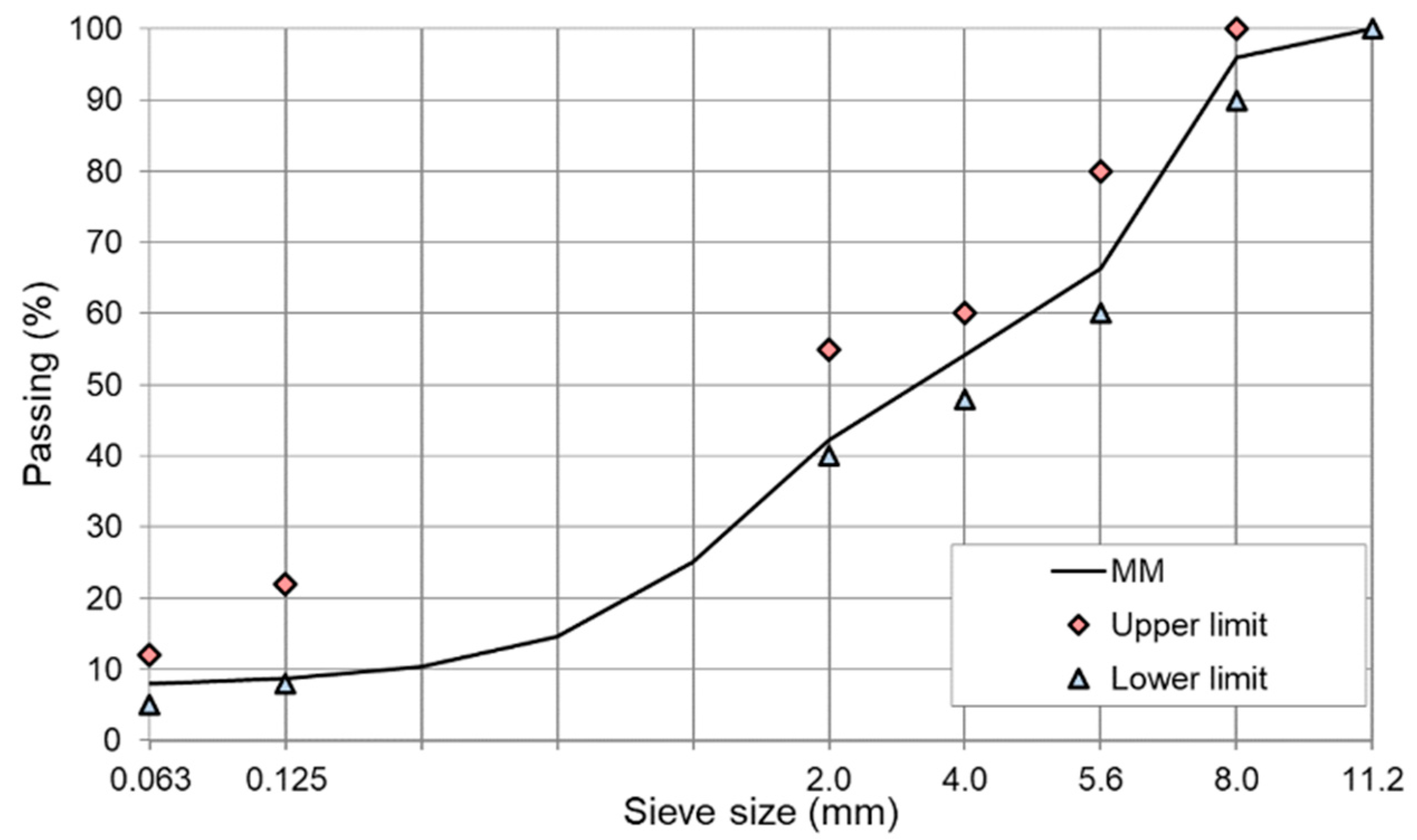
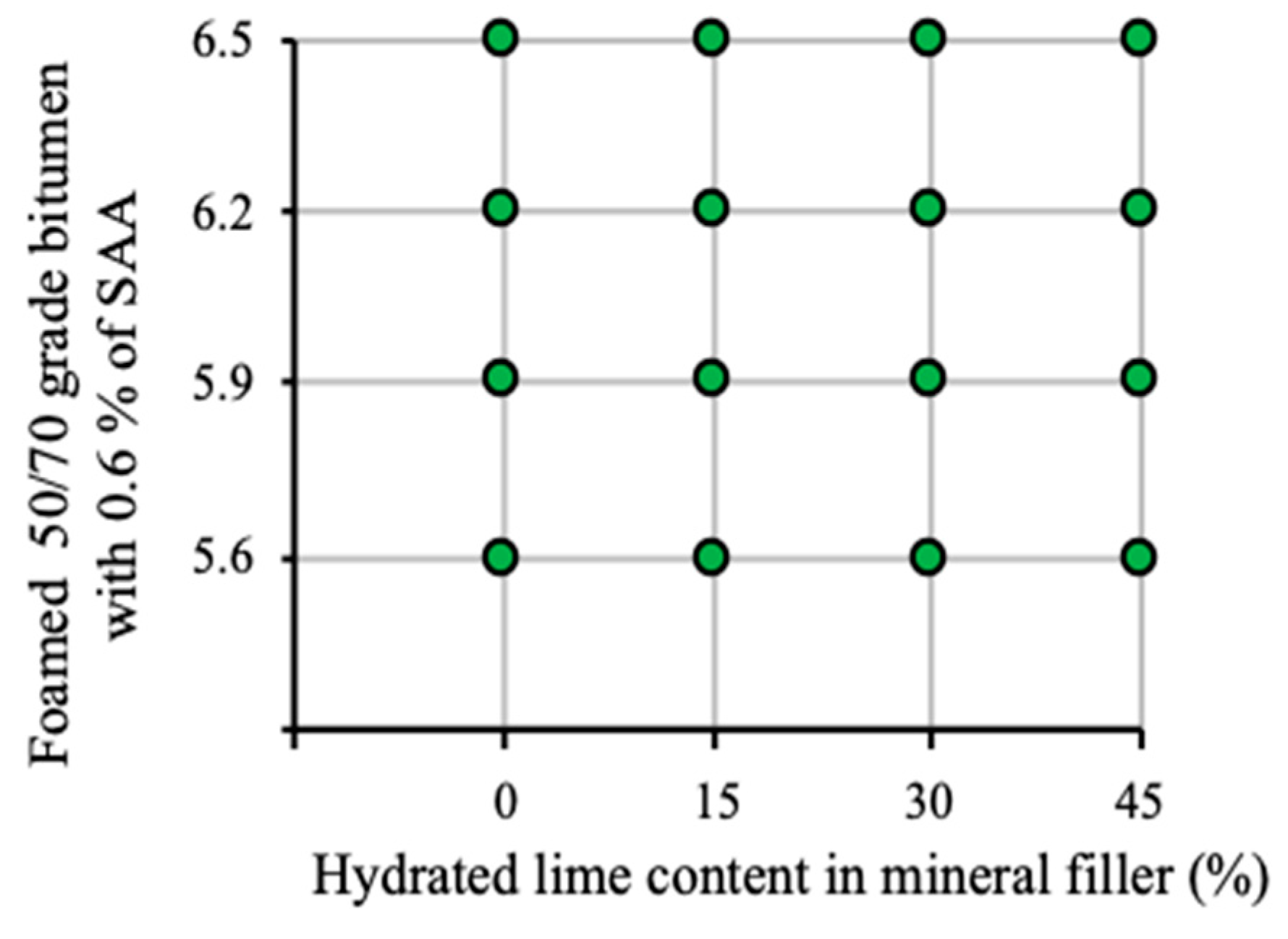
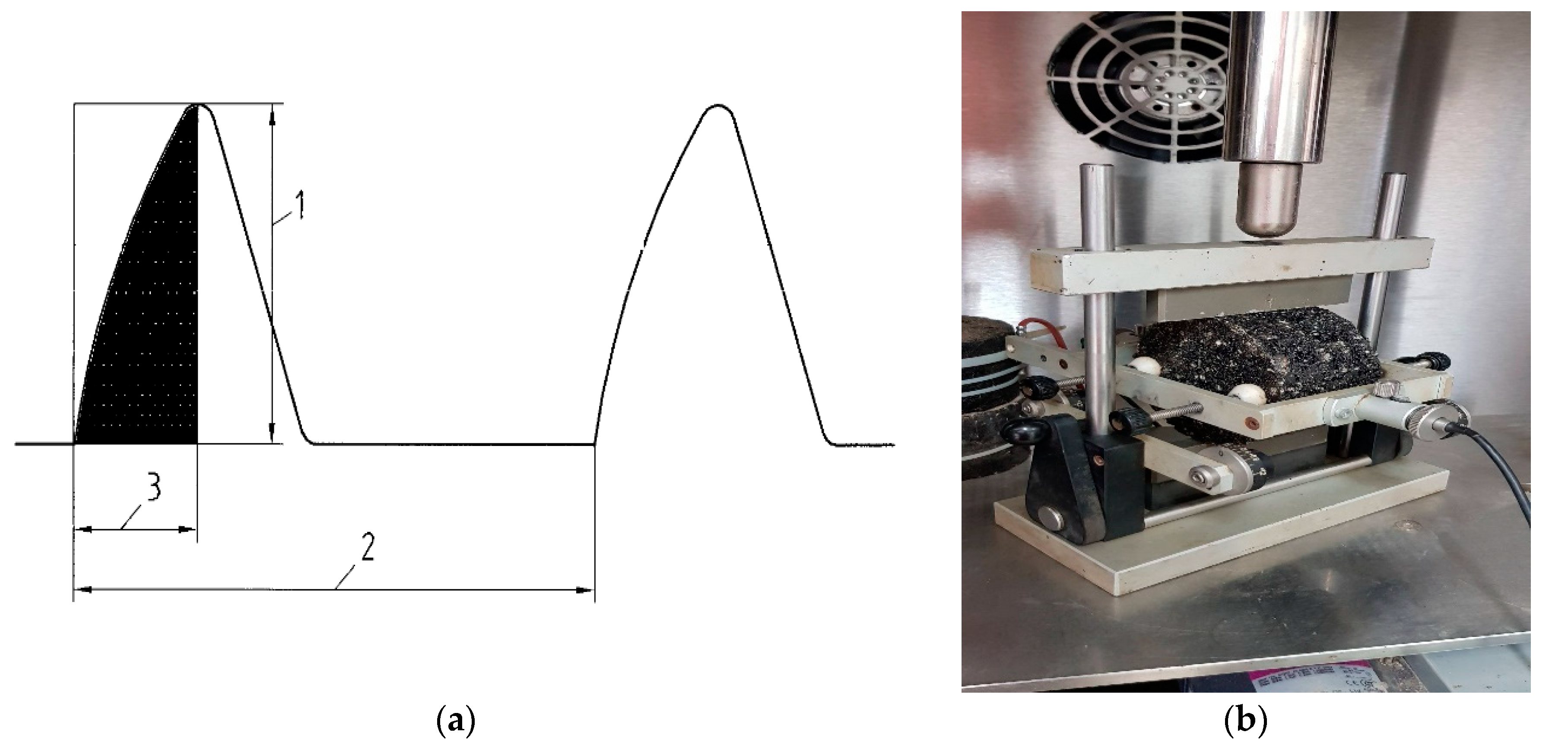

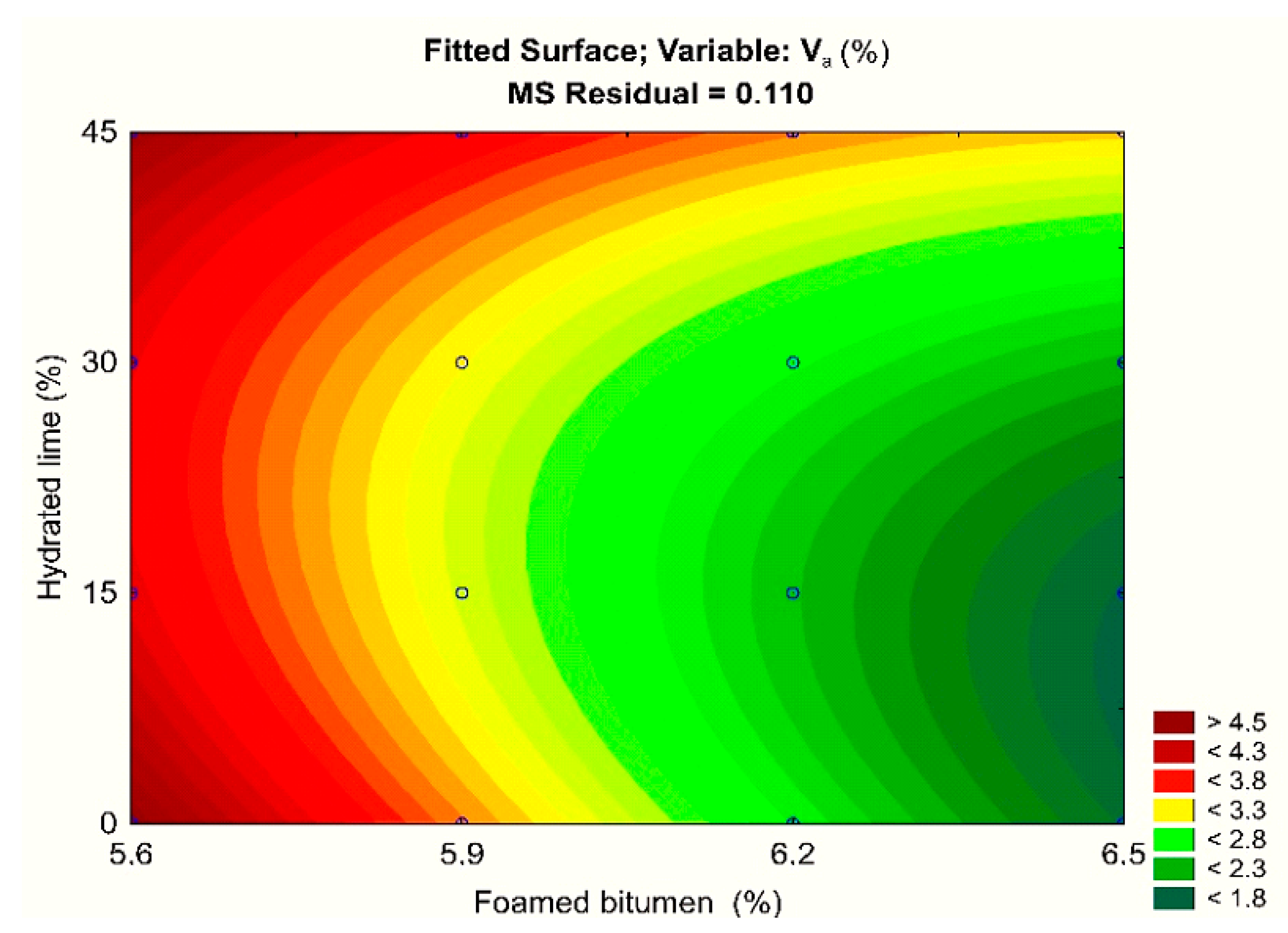

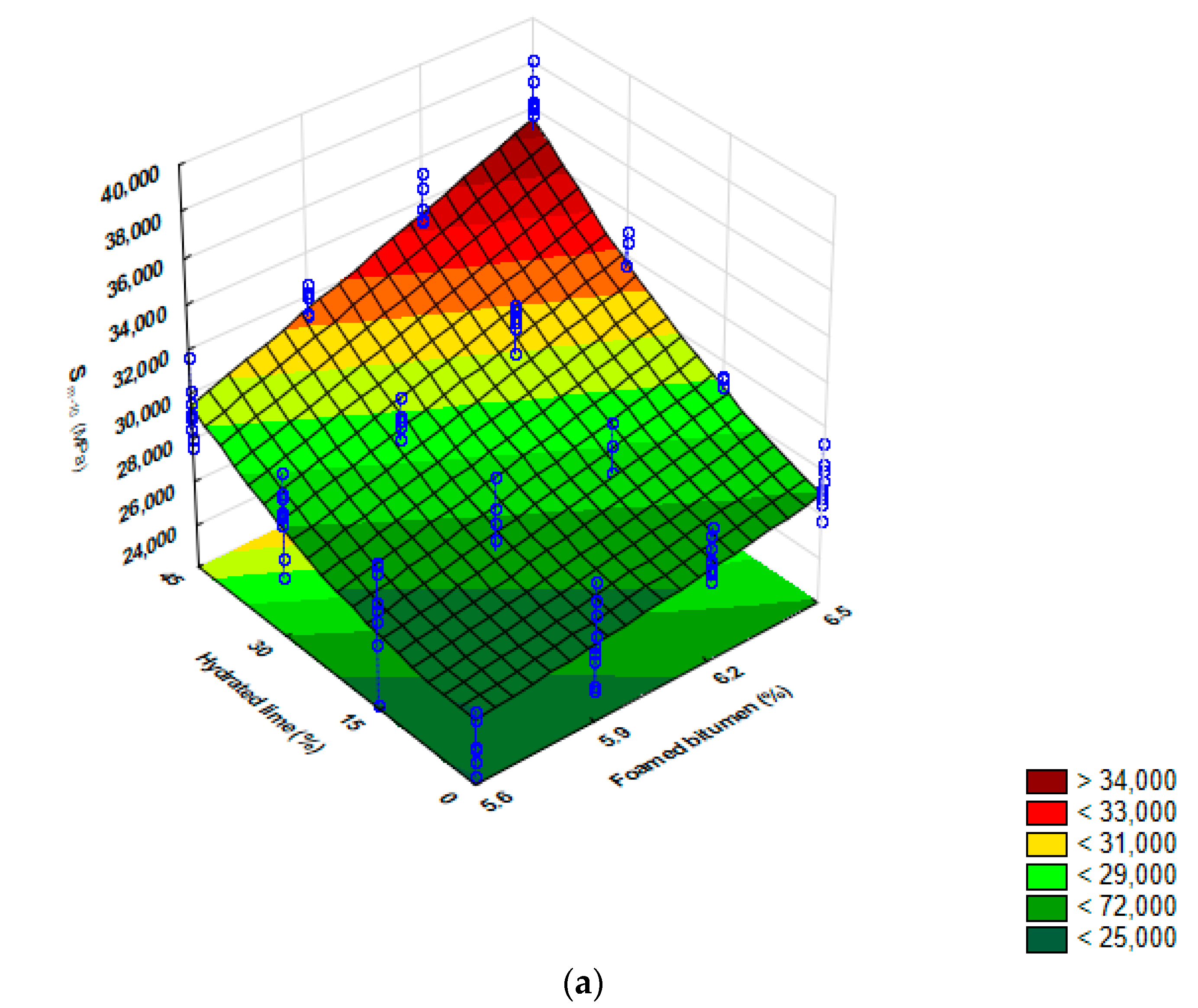
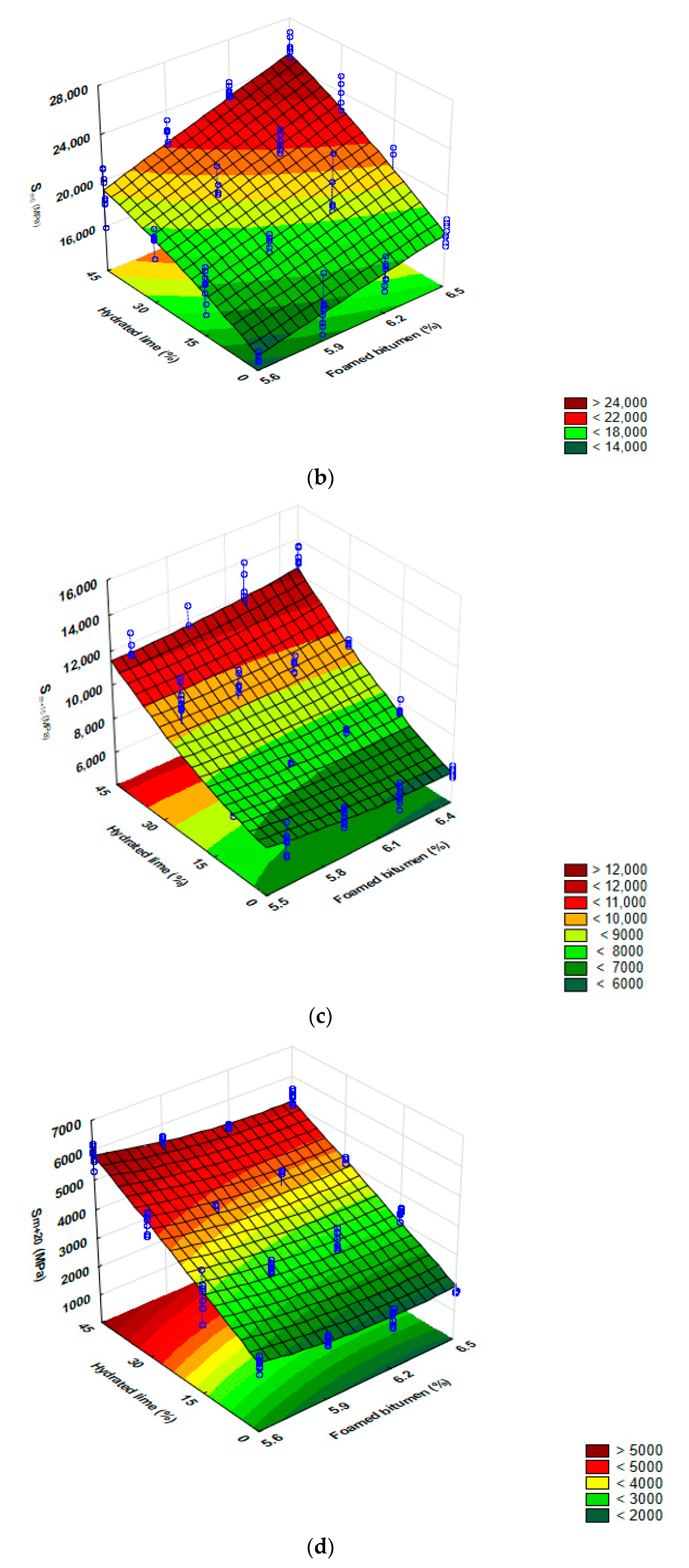
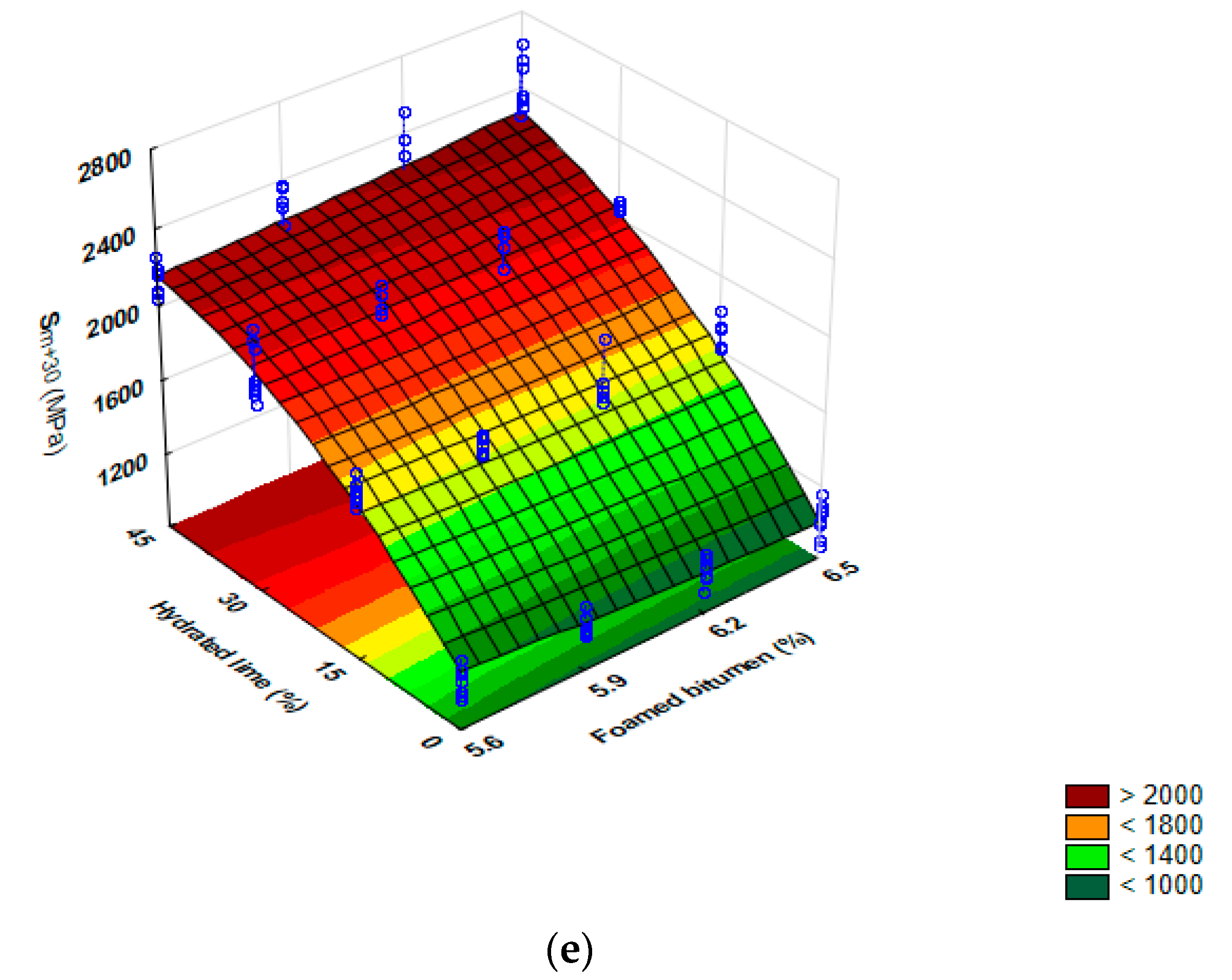
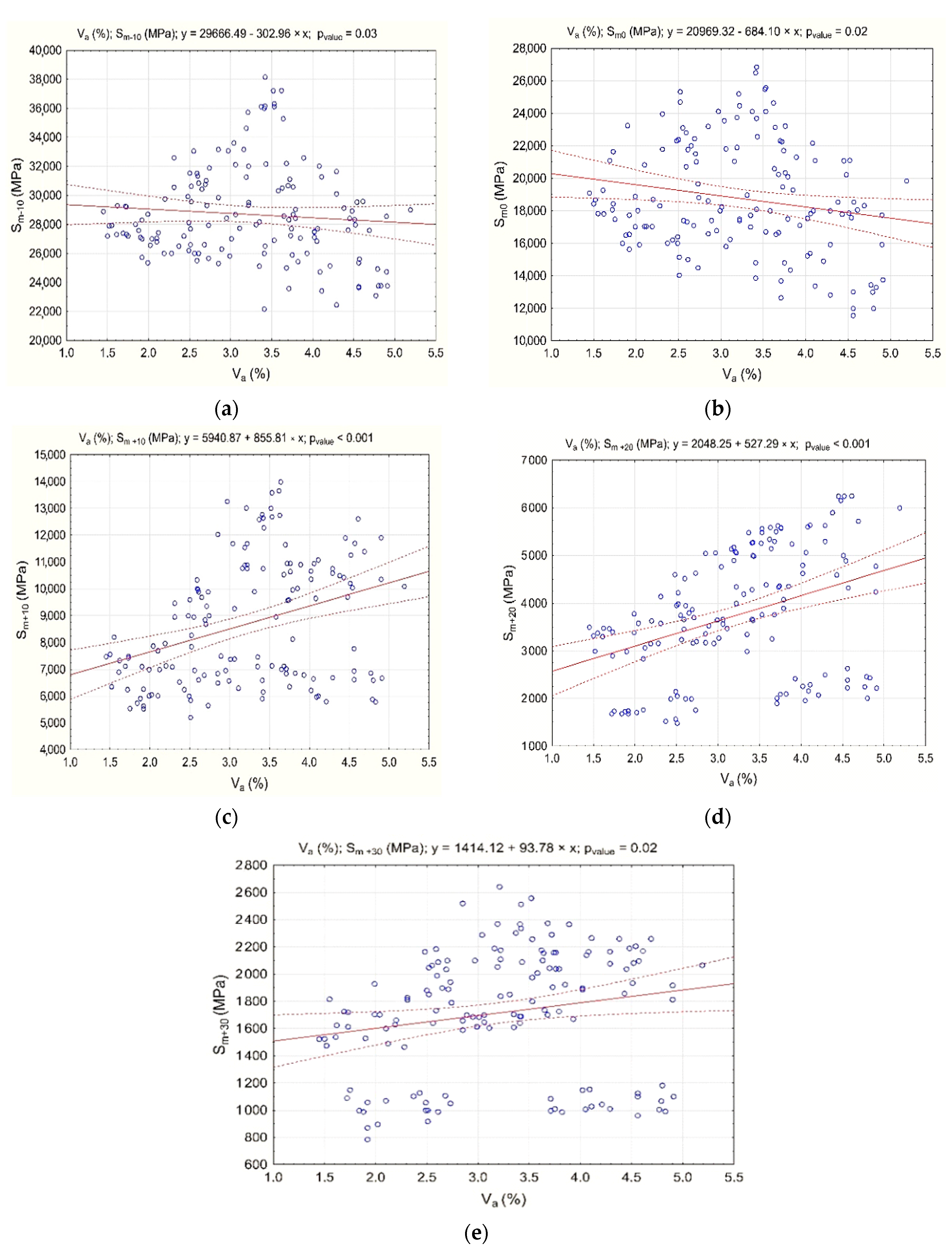
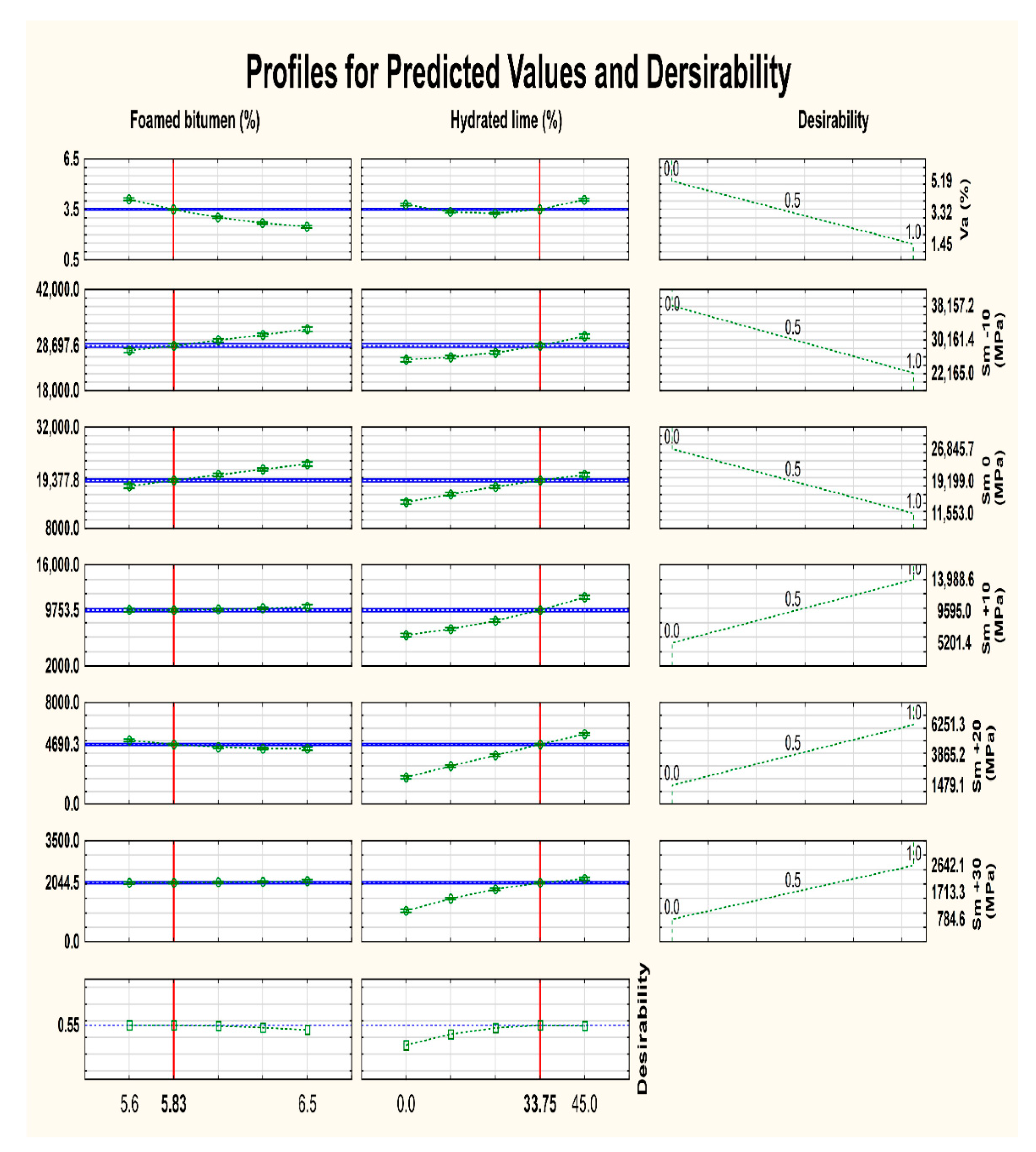
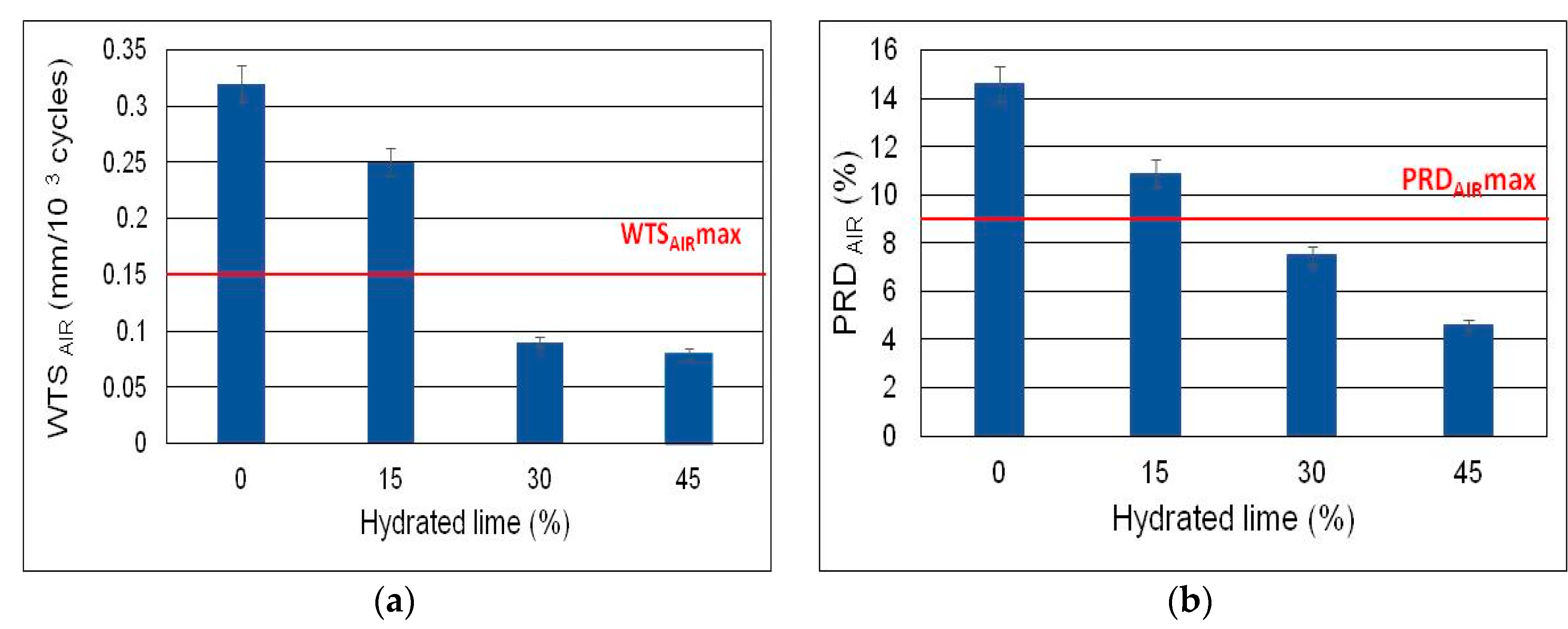
| Property | Unit | Testing Method | Bitumen | |
|---|---|---|---|---|
| 50/700 | 50/70 + 0.6% SAA | |||
| Penetration at 25 °C | 0.1 mm | PN-EN 1426 | 65.9 | 70.4 |
| Softening point TR&B | °C | PN-EN 1427 | 50.4 | 48.8 |
| Fraass breaking point | °C | PN-EN 12593 | −15.1 | −14.2 |
| Temperature plasticity range | °C | - | 65.5 | 63.0 |
| Penetration Index | - | EN 12591 | −0.6 | 1.4 |
| Expansion ratio (ER) | - | - | 11 | 19 |
| Half-life t1/2 | s | - | 10 | 21 |
| Foaming water content (FWC) | % | - | 2.5 | 2.5 |
| Property | Test | u.m. | Symbol |
|---|---|---|---|
| Dimension d/D | EN 933-1 | - | 0/2 |
| Particle size distribution | EN 933-1 | - | GF85 |
| Density | EN 1097-6 | Mg/m3 | 2.73 |
| Property | Test | u.m. | Symbol | |
|---|---|---|---|---|
| Dimension d/D | EN 933-1 | - | 2/5 | 4/8 |
| Particle size distribution | EN 933-1 | - | GA85 | GA85 |
| Density | EN 1097-6 | Mg/m3 | 2.98 | 2.98 |
| Shape index | EN 933-4 | % | SI20 | SI15 |
| Flakiness index | EN 933-3 | % | FI20 | FI15 |
| Percentage of crushed and broken surfaces | EN 933-5 | % | C90/3 | C100/0 |
| Frost resistance | EN 1367-1 | % | F1 | F1 |
| Abrasion resistance | EN1097-1 | % | - | MDE15 |
| Resistance to fragmentation | EN 1097-2 | % | - | LA15 |
| Materials | Mineral Mixture (% m/m) | Bituminous Mixture (% m/m) |
|---|---|---|
| Filler (limestone aggregate) | 7.0 | 6.6 |
| Crushed fine continuously graded aggregate 0/2 mm (limestone) | 37.0 | 34.8 |
| Coarse aggregate 2/5 mm (gabbro) | 16.0 | 15.1 |
| Coarse aggregate 4/8 mm (gabbro) | 40.0 | 37.7 |
| 50/70 penetration paving-grade bitumen | - | 5.6 |
| Total | 100.0 | 100.0 |
| Effect | Regression Coeff. | SE | p-Value | −95% Cnf. Lmt | +95% Cnf. Lmt |
|---|---|---|---|---|---|
| Variable: Va (%), R2 = 0.880; R2 adj. = 0.875 | |||||
| Intercept | 68.159 | 6.791 | <0.001 | 54.720 | 81.596 |
| (1) Foamed bitumen (%)(L) | −18.425 | 2.247 | <0.001 | −22.872 | −1.978 |
| Foamed bitumen (%)(Q) | 1.266 | 0.185 | <0.001 | 0.898 | 1.6334 |
| (2) Hydrated lime (%)(L) | −0.276 | 0.018 | <0.001 | −0.13 | −0.241 |
| Hydrated lime (%)(Q) | 0.001 | 0.001 | <0.001 | <0.001 | <0.001 |
| 1 L ∗ 2 L | 0.038 | 0.003 | <0.001 | 0.032 | 0.044 |
| Effect | Regression Coeff. | SE | p-Value | −95% Cnf. Lmt | +95% Cnf. Lmt |
|---|---|---|---|---|---|
| Variable: Sm-10 (MPa), R2 = 0.8187; R2 adj = 0.8122, Pure Error MS = 1,809,712 | |||||
| Intercept | 31,976.28 | 45,578.49 | 0.4842 | −58,208.5 | 122,161.1 |
| (1) Foamed bitumen (%)(L) | −4250.82 | 15,082.22 | 0.7785 | −34,093.6 | 25,591.9 |
| Foamed bitumen (%)(Q) | 535.14 | 1245.61 | 0.6682 | −1929.5 | 2999.8 |
| (2) Hydrated Lime (%)(L) | −560.66 | 122.82 | <0.001 | −803.7 | −317.6 |
| Hydrated Lime (%)(Q) | 2.21 | 0.50 | <0.001 | 1.2 | 3.2 |
| 1 L × 2 L | 100.37 | 19.93 | <0.001 | 60.9 | 139.8 |
| Variable: Sm0 (MPa); R2 = 0.8567; R2 adj = 0.8512; Pure Error = 1743,61 | |||||
| Intercept | −14,876.7 | 44,742.85 | 0.7401 | −103,408 | 73,654.63 |
| (1) Foamed bitumen (%)(L) | 6178.5 | 14,805.70 | 0.6771 | −23,117 | 35,474.09 |
| Foamed bitumen (%)(Q) | −203.2 | 1222.77 | 0.8683 | −2623 | 2216.31 |
| (2) Hydrated Lime (%)(L) | −178.1 | 120.57 | 0.1422 | −417 | 60.52 |
| Hydrated Lime (%)(Q) | −0.8 | 0.49 | 0.1111 | −2 | 0.18 |
| 1 L × 2 L | 61.4 | 19.56 | <0.001 | 23 | 100.06 |
| Variable: Sm10 (MPa); R2 = 0.8714, R2 adj = 0.8667, Pure Error MS = 45,0536.1 | |||||
| 42,843.7 | 22,741.54 | 0.0618 | −2,154.3 | 87,841.71 | |
| (1) Foamed bitumen (%)(L) | −11,206.5 | 7525.32 | 0.1389 | −26,096.6 | 3683.69 |
| Foamed bitumen (%)(Q) | 846.5 | 621.50 | 0.1756 | −383.3 | 2076.24 |
| (2) Hydrated Lime (%)(L) | −194.2 | 61.28 | <0.001 | −315.4 | −72.92 |
| Hydrated Lime (%)(Q) | 1.2 | 0.25 | <0.001 | 0.8 | 1.74 |
| 1 L × 2 L | 43.8 | 9.94 | <0.001 | 24.1 | 63.43 |
| Variable: Sm20 (MPa); R2 = 0.9434; R2 adj = 0.946; Pure Error MS = 79,096.06 | |||||
| Intercept | 44,108.5 | 9528.677 | <0.001 | 25,254.4 | 62,962.65 |
| (1) Foamed bitumen (%)(L) | −13,433.1 | 3153.101 | <0.001 | −19,672.1 | −7194.16 |
| Foamed bitumen (%)(Q) | 1068.0 | 260.408 | <0.001 | 552.7 | 1583.2 |
| (2) Hydrated Lime (%)(L) | 117.0 | 25.678 | <0.001 | 66.2 | 167.82 |
| Hydrated Lime (%)(Q) | −0.1 | 0.104 | 0.3932 | −0.3 | 0.12 |
| 1 L × 2 L | −6.4 | 4.167 | 0.1282 | −14.6 | 1.86 |
| Variable: Sm30 (MPa); R2 = 0.9285, R2 adj = 0.9259, Pure Error MS = 15,126.99 | |||||
| Intercept | 4073.402 | 4167.076 | 0.3303 | −4171.87 | 12,318.67 |
| (1) Foamed bitumen (%)(L) | −872.150 | 1378.912 | 0.5282 | −3600.56 | 1856.26 |
| Foamed bitumen (%)(Q) | 61.340 | 113.881 | 0.5911 | −163.99 | 286.67 |
| (2) Hydrated Lime (%)(L) | 6.551 | 11.229 | 0.5606 | −15.67 | 28.77 |
| Hydrated Lime (%)(Q) | −0.376 | 0.046 | <0.001 | −0.47 | −0.29 |
| 1 L × 2 L | 5.991 | 1.822 | <0.001 | 2.39 | 9.60 |
| Variable | Sm-10 (MPa) | Sm+30 (MPa) | Sm+20 (MPa) | Sm+10 (MPa) | Sm0 (MPa) | Va (%) |
|---|---|---|---|---|---|---|
| Sm-10 (MPa) | 1.000 | 0.719 | 0.617 | 0.731 | 0.806 | −0.086 |
| p = --- | p ≤ 0.001 | p ≤ 0.001 | p ≤ 0.001 | p ≤ 0.001 | p = 0.30 | |
| Sm+30 (MPa) | 0.719 | 1.000 | 0.912 | 0.847 | 0.756 | 0.191 |
| p ≤ 0.001 | p = --- | p ≤ 0.001 | p ≤ 0.001 | p ≤ 0.001 | p = 0.02 | |
| Sm+20 (MPa) | 0.617 | 0.9122 | 1.000 | 0.869 | 0.645 | 0.377 |
| p ≤ 0.001 | p ≤ 0.001 | p = --- | p ≤ 0.001 | p ≤ 0.001 | p ≤ 0.001 | |
| Sm+10 (MPa) | 0,731 | 0.847 | 0.869 | 1.000 | 0,696 | 0.347 |
| p ≤ 0.001 | p ≤ 0.001 | p ≤ 0.001 | p = --- | p ≤ 0.001 | p ≤ 0.001 | |
| Sm0 (MPa) | 0.805 | 0.756 | 0.645 | 0.696 | 1.000 | −0.187 |
| p ≤ 0.001 | p ≤ 0.001 | p ≤ 0.001 | p ≤ 0.001 | P = --- | p = 0.02 | |
| Va (%) | −0.086 | 0.191 | 0.377 | 0.347 | −0.187 | 1.000 |
| p = 0.303 | p = 0.022 | p ≤ 0.001 | p ≤ 0.001 | p = 0.025 | p = --- |
| Dependent Variable | SS Test for the Full Model with Respect to SS for Residual | ||||||||
|---|---|---|---|---|---|---|---|---|---|
| Multicrit. R | Multicrit. R2 | Adjusted. R2 | SS Model | MS Model | SS Residual | MS Residual | F | p | |
| Va (%) | 0.908 | 0.826 | 0.821 | 1.043 × 102 | 26 | 22 | 0 | 165.1 | <0.001 |
| Sm-10 (MPa) | 0.888 | 0.789 | 0.783 | 1.224 × 109 | 305,969,940 | 326,976,774 | 2,352,351 | 130.0 | <0.001 |
| Sm0 (MPa) | 0.920 | 0.846 | 0.842 | 1.435 × 109 | 358,641,446 | 259,957,219 | 1,870,196 | 191.7 | <0.001 |
| Sm +10 (MPa) | 0.927 | 0.860 | 0.856 | 6.603 × 108 | 165,078,470 | 107,443,778 | 772,977 | 213.5 | <0.001 |
| Sm+20 (MPa) | 0.971 | 0.942 | 0.941 | 2.325 × 108 | 58,116,523 | 14,086,527 | 101,342 | 573.4 | <0.001 |
| Sm+30 (MPa) | 0.960 | 0.923 | 0.920 | 2.811 × 107 | 7,028,122 | 2,340,397 | 16,837 | 417.4 | <0.001 |
Publisher’s Note: MDPI stays neutral with regard to jurisdictional claims in published maps and institutional affiliations. |
© 2020 by the author. Licensee MDPI, Basel, Switzerland. This article is an open access article distributed under the terms and conditions of the Creative Commons Attribution (CC BY) license (http://creativecommons.org/licenses/by/4.0/).
Share and Cite
Iwański, M.M. Effect of Hydrated Lime on Indirect Tensile Stiffness Modulus of Asphalt Concrete Produced in Half-Warm Mix Technology. Materials 2020, 13, 4731. https://doi.org/10.3390/ma13214731
Iwański MM. Effect of Hydrated Lime on Indirect Tensile Stiffness Modulus of Asphalt Concrete Produced in Half-Warm Mix Technology. Materials. 2020; 13(21):4731. https://doi.org/10.3390/ma13214731
Chicago/Turabian StyleIwański, Mateusz M. 2020. "Effect of Hydrated Lime on Indirect Tensile Stiffness Modulus of Asphalt Concrete Produced in Half-Warm Mix Technology" Materials 13, no. 21: 4731. https://doi.org/10.3390/ma13214731
APA StyleIwański, M. M. (2020). Effect of Hydrated Lime on Indirect Tensile Stiffness Modulus of Asphalt Concrete Produced in Half-Warm Mix Technology. Materials, 13(21), 4731. https://doi.org/10.3390/ma13214731





